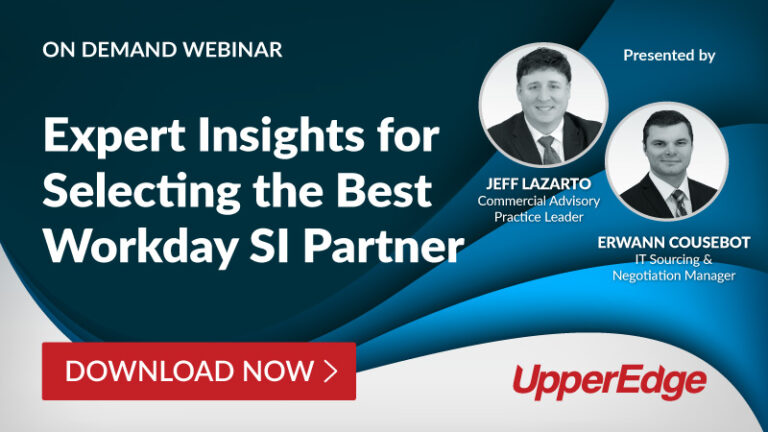- Jeff Lazarto
- Reading Time: 4 minutes

Workday recently announced a strong first quarter and increased guidance for the remainder of their fiscal year. This is great news for Workday and a positive sign that the application software industry as a whole is emerging from the pandemic with a return to high growth. But is all this growth good for Workday customers?
Workday Growth Metrics
For the purpose of this article, we are focusing on the annual revenue and employee headcount metrics. Workday’s new annual revenue guidance for FY’22 is a range of $4.425B to $4.440B, with a longer-term strategic goal of reaching $10B annually by 2025. Workday might get there if they can achieve consistent growth in the 20% range, but this is a very aggressive goal.
From a worker headcount perspective, Workday is currently around 13,100 employees with an aggressive 20% annual growth goal or 2,500 new employees in FY’22. The company has already added roughly 600 employees in Q1. Achieving this goal would put Workday at roughly 15,600 employees.
From a historical perspective, in 2017 Workday had close to 6,600 employees with annual growth rates in the mid to high 20’s for the next few years before cooling off during the pandemic. In four years, Workday has practically doubled their employee headcount, both organically and through acquisitions.
This type of hyper-growth will create challenges for Workday that could possibly impact Workday customers negatively.
Culture Shock
While the actual culture of each business varies, most CEOs stress the importance of maintaining their company culture and ensuring alignment with their mission and values. The challenge that comes with hyper employee growth is ensuring new employees adopt the company culture. Every new employee comes with their own unique experiences and biases. The magnitude of these biases can really shock a company depending on how different they are from the company culture.
These biases are then magnified by the size and rate of growth. Gradual employee growth allows the core company culture to remain dominant while the new employees, through onboarding programs, training, and interaction with incumbent employees, start to adopt the core company culture or risk being rejected. It may take some time, but the dominant company culture will typically prevail.
However, rapid growth, especially through acquisition, can create clusters of employees with different cultural aspects that may not align with the core company culture. These large numbers can resist cultural assimilation and even erode the culture of the incumbent employees. This can lead to separate silos within a company and result in inconsistent values and behaviors.
Potential Impact to Customers
The most obvious potential impact for customers would occur in their interactions with Workday’s sales and support teams. While they have enjoyed a high customer satisfaction rating to date, we are seeing signs that this is beginning to slightly erode.
Workday has stated that their employee growth focus is adding to their sales, pre-sales, and business development teams. We are hearing from customers that there is a significant growing number of ex-Oracle salespeople that are joining Workday who are bringing their Oracle’s sales tactics with them. Workday’s customer relationship approach has been completely different than Oracle’s and is one of the key differentiators that has led to Workday’s success and high customer satisfaction ratings. The influx of sales reps from Oracle and other organizations may result in very different sales communication approaches and possibly be counter to why customers chose Workday in the first place.
When you layer in super aggressive revenue growth goals, the focus of the management team can quickly shift to driving revenue growth at all costs and at the expense of culture and core product enhancements. Workday will continue to add solutions through acquisitions and new product development. This prioritizing of new solutions can lead to Workday losing focus in continuing to develop enhancements within their current core HCM applications. Some customers have voiced their concern that Workday is neglecting their core business applications in favor of pursuing building new modules that require additional subscriptions. Customers may feel alienated if this concern takes hold within Workday and expands.
Additionally, the focus on hyper revenue growth can lead to more aggressive sales tactics, such as substantial renewal term price increases if the renewal is not accompanied with product expansion. Workday will need to justify their growth investments, whether from adding headcount to their sales and marketing teams or expanding their solution portfolio organically and through acquisition. Investors expect to see a significant ROI and this added pressure may lead to behavioral changes in how Workday interacts with their customers.
While Workday customers may be in a honeymoon phase today, as Workday evolves, competition intensifies, and renewal rates continue to rise, your Workday relationship may regress. If you think this is just idle speculation, take a look at the challenges many Salesforce customers are starting to face.
Customer Action Plan
Workday customers can guard against these potential changes by establishing and actively maintaining executive-level relationships. This includes continuously expanding those relationships within both organizations. The more senior the Workday resource, the more likely they embody Workday’s core culture and values. These senior relationships can then be leveraged to maintain consistent communication approaches between Workday sales and services reps and your company. Nobody likes to upset their higher-ups, so having strong executive relationships will minimize the likelihood of sales and services reps communicating or interacting with you in a manner that is inconsistent with Workday’s culture and values; and if they do, you have the ability to stop it in its tracks with a phone call.
It is also advisable to establish a formal account management plan with quarterly, semi-annual, or annual meetings. The attendees for the meetings may vary depending on the size of your company and the meeting agenda but having a regular meeting cadence is valuable. This will enable you to keep abreast of Workday product development updates, solicit insights into value realization opportunities, and discuss future roadmap plans. The result is an actively warm relationship that you can tap into as needed.
Also, keep in mind how much of a partner you are to Workday, beyond just paying your subscription fees. Your willingness to conduct reference calls, make referrals, speak at conferences, etc., go a long way in building a relationship and establishing trust. In our experience, customers who make relationship development a priority and are willing to offer benefits to Workday outside of just paying their fees on time are the ones who receive reciprocal treatment from Workday.
Post a comment below, follow me on Twitter @jeffrey_lazarto, find my other UpperEdge blogs, and follow UpperEdge on Twitter and LinkedIn. Learn more about our Workday Commercial Advisory Services.
Related Blogs
From Announcements to Acquisitions: How Workday’s AI Strategy Should Shape Your Negotiation Approach
Workday’s Latest AI Announcements: What You Need to Know Before Entering the Negotiation Room
The Key to Getting Your Workday Negotiations Right
About the Author

